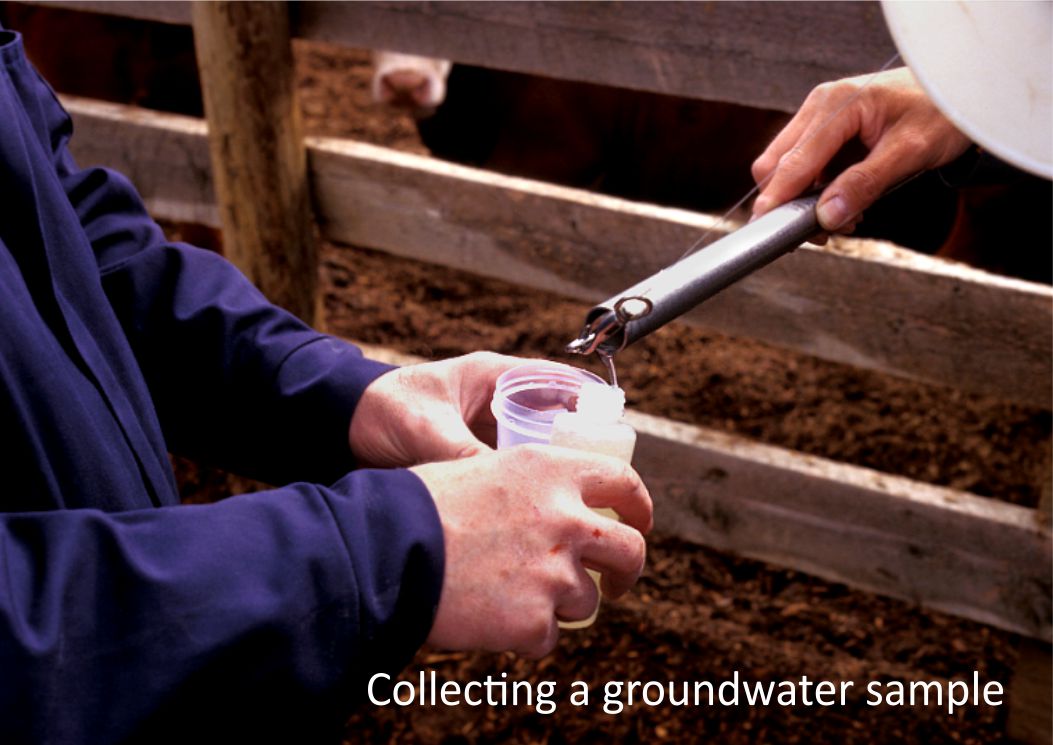| | Introduction | Study methods | Findings | Project Support | Publications | For More Information
Introduction
Environmental concerns related to manure management have often focused on land application and the potential for negative effects on soil and water quality. However, there is also potential for contamination of soil and water directly from feedlot sites.
Study Methods
 In late 1995 and early 1996, a research cattle (Bos taurus) feedlot was constructed at the Agriculture and Agri-Food Canada Research Centre at Lethbridge, Alberta. This provided an opportunity to study the effects of a new feedlot on soil quality and shallow groundwater quality. Sixteen groundwater wells were installed at the feedlot site: nine wells within the pen area, four wells south of the pens, and three wells north of the pens. Groundwater chemistry was monitored from April, 1996 to November, 2000. Groundwater microbiology was measured twice in 1996 and from May, 1998 to January, 2001. Baseline soil samples were collected from the pen area in 1996, and a second set of soil samples was collected in 1999. In late 1995 and early 1996, a research cattle (Bos taurus) feedlot was constructed at the Agriculture and Agri-Food Canada Research Centre at Lethbridge, Alberta. This provided an opportunity to study the effects of a new feedlot on soil quality and shallow groundwater quality. Sixteen groundwater wells were installed at the feedlot site: nine wells within the pen area, four wells south of the pens, and three wells north of the pens. Groundwater chemistry was monitored from April, 1996 to November, 2000. Groundwater microbiology was measured twice in 1996 and from May, 1998 to January, 2001. Baseline soil samples were collected from the pen area in 1996, and a second set of soil samples was collected in 1999.
Findings
The water-table depth, on average, ranged from 1.23 to 2.50 m during the study. The surface topography of the water table changed under the feedlot. By late 1997, the water-table was at a higher elevation under the pen area than outside the pen area. This difference in water-table elevation between the pen area and outside the pen area persisted throughout the rest of the study. Some soil chemical properties were only affected in the top layer (0–15 cm), such as an increase in extractable phosphate-P, extractable nitrate-N, extractable ammonium-N, and extractable potassium. These increases may simply be as much the result of mechanical mixing by the action of animal hooves, as to leaching. Other soil properties increased significantly to greater depths (down to 60 cm), such as electrical conductivity, sulphate-S, extractable magnesium, extractable calcium, extractable sodium, and SAR. However, chloride content increased significantly throughout the entire soil profile (0–150 cm), providing evidence that leaching occurred under the feedlot pens. Groundwater analysis also indicated that contaminants had leached to the water table. The strongest evidence was from increased chloride concentrations, E. coli counts, and total coliform counts in the wells within the pen area, whereas there was very little change in the wells outside of the pen area. The pen area may not contribute uniformly to downward movement of contaminants to the water table. We believe that the drainage alleys may be a significant means whereby water can infiltrate into the soil below the feedlot.
Project Support
Partial funding for this project was provided by the Canada-Alberta Beef Industry Development Fund.
Publications
Published Paper
Olson, B.M., Miller, J.J., Rodvang, S.J., and Yanke, L.J. 2005. Soil and groundwater quality under a cattle feedlot in southern Alberta. Water Quality Research Journal of Canada 40: 131–144.
Final Technical Report
Soil and groundwater quality monitoring under a research feedlot in southern Alberta
For More Information
Barry Olson
Alberta Agriculture and Forestry
Lethbridge, Alberta
Toll free 310-0000
Phone: 403-381-5884
Email: barry.olson@gov.ab.ca
|
|